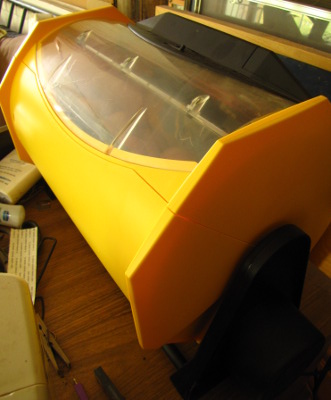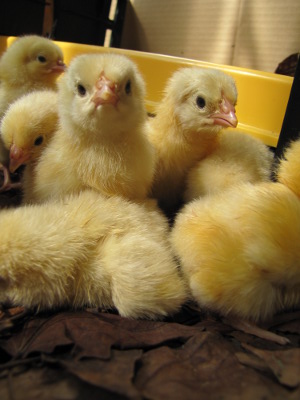
Chicken incubation questions
 Incubating
my own chicks this year allowed me to experiment with smaller
batches
than I could get from a hatchery while also trying out rare varieties
of non-nursery stock. There was a steep learning curve, though,
and I soon learned that incubating is more complex than setting the
temperature and number of days in the incubator and then forgetting the
chicks until they hatched. Here are some of the questions I asked
as I went from a beginner to an intermediate incubator.
Incubating
my own chicks this year allowed me to experiment with smaller
batches
than I could get from a hatchery while also trying out rare varieties
of non-nursery stock. There was a steep learning curve, though,
and I soon learned that incubating is more complex than setting the
temperature and number of days in the incubator and then forgetting the
chicks until they hatched. Here are some of the questions I asked
as I went from a beginner to an intermediate incubator.
 What kind of incubator should I
use? We've
tried three different incubators, and the only one that worked well for
us was the Brinsea
Octagon 20 Advance.
At $300, the Octagon 20 isn't an incubator to buy on a whim, but the
lack of climate control in our trailer made the cheap Little
Giant Still Air Incubator that we bought at the local
feed store totally worthless. The Brinsea
Mini Advance Incubator
worked a little better (we got one surviving chick out of seven eggs),
but that incubator's utility is really in allowing you to see a hatch
up close and personal. It's agonizing to watch chicks who had an
improper incubation period try to struggle out of their shells and
fail, so if you're going to incubate, you should probably do it right.
What kind of incubator should I
use? We've
tried three different incubators, and the only one that worked well for
us was the Brinsea
Octagon 20 Advance.
At $300, the Octagon 20 isn't an incubator to buy on a whim, but the
lack of climate control in our trailer made the cheap Little
Giant Still Air Incubator that we bought at the local
feed store totally worthless. The Brinsea
Mini Advance Incubator
worked a little better (we got one surviving chick out of seven eggs),
but that incubator's utility is really in allowing you to see a hatch
up close and personal. It's agonizing to watch chicks who had an
improper incubation period try to struggle out of their shells and
fail, so if you're going to incubate, you should probably do it right.
Is
every egg created equal? No, and you'll have a
much better hatch rate if you put only the best eggs in your
incubator. Eggs to discard include those with even a tiny bit of
poop  on the shell, porous eggs that
seem to be speckled when you hold them up to the light, and eggs from
hens more than two years old. Of course, cracked eggs or eggs
that have been stored
improperly shouldn't be included. In addition, more eggs tend
to be fertile in the spring and fall than in the summer and winter.
on the shell, porous eggs that
seem to be speckled when you hold them up to the light, and eggs from
hens more than two years old. Of course, cracked eggs or eggs
that have been stored
improperly shouldn't be included. In addition, more eggs tend
to be fertile in the spring and fall than in the summer and winter.
How
many chicks should I expect? If you're doing
everything just right, you should expect 75% to 80% of homegrown eggs
to hatch. Mail
ordered hatching eggs
will have been bumped around in the post office, so 50% is considered a
good hatch rate there. You can tell whether a low hatch rate is
caused by your mistakes or by bad eggs if you count how many eggs were infertile. If you're a raw
beginner, put a lot more eggs than you need in the incubator --- I
ended up with only one living chick my first time around and had to
scurry to find it friends. (A lone chick is an unhappy
chick.) By my fourth hatch, though, I got a 58% hatch rate from
mail order eggs and felt very accomplished.
 What's dry
incubation and should I do it? Mainstream hatching
literature tells you to add water to the wells in order to keep your
incubator at 40% to 50% humidity for the first 19 days. However,
many experienced hatchers report that running the incubator dry gives
them better hatch rates. Whether dry incubation works for you
will probably depend on your climate. The best way to decide
whether humidity in your incubator is in the right range is to weigh
your eggs every few
days and make sure they lose 13% of their weight by day 18.
What's dry
incubation and should I do it? Mainstream hatching
literature tells you to add water to the wells in order to keep your
incubator at 40% to 50% humidity for the first 19 days. However,
many experienced hatchers report that running the incubator dry gives
them better hatch rates. Whether dry incubation works for you
will probably depend on your climate. The best way to decide
whether humidity in your incubator is in the right range is to weigh
your eggs every few
days and make sure they lose 13% of their weight by day 18.
 How and when should I prepare for
the hatch?
No matter whether you practice conventional or dry incubation, you want
to increase the humidity in the incubator to 65% or more on day 19 so
that the chicks will slide right out of their shells. This is
also the time for you to turn off the egg turner and remove any
dividers so that the eggs lay flat on their sides. If the well of
the incubator is chick-accessible, but sure to shield it so that no
chicks can fall in and drown.
How and when should I prepare for
the hatch?
No matter whether you practice conventional or dry incubation, you want
to increase the humidity in the incubator to 65% or more on day 19 so
that the chicks will slide right out of their shells. This is
also the time for you to turn off the egg turner and remove any
dividers so that the eggs lay flat on their sides. If the well of
the incubator is chick-accessible, but sure to shield it so that no
chicks can fall in and drown.
How
often should I open the incubator? You'll read that you
can only open the incubator once or twice a day during the hatch period
or the humidity will plummet, but I found simple ways to keep
the humidity high
while poking around inside as much as I liked. Despite
conventional wisdom, I've had best results moving chicks to the brooder
an hour or less after they hatched so that they don't injure other
chicks busy struggling out of their shells.
Should
I help
chicks hatch?
It's okay to help chicks hatch as long as you understand what
constitutes an abnormal hatch. A chick pipping
at the narrow end of the egg should always be helped
because healthy chicks will either die while trying to struggle out of
this improper position or will injure
themselves.
You might choose to help chicks that have pipped but not started to
unzip for an abnormal length of time (generally 24 hours, or until the
membrane starts to turn brown and dry), but in this case you're more
likely to be aiding a weak chick which that might have to be culled.
How
and when should I cull a chick? After helping a chick,
I generally put it in a spare incubator for a few hours to regain its
strengh, then move it to the brooder to join the other chicks. If
they attack the chick, chances are it's too weak and would die on its
own. In that case, I put the chick
in an airtight container with some baking soda and vinegar and it dies
relatively painlessly within seconds.
 Is there an easier way to hatch
chicks? A broody
hen can do all of the work for you, but only certain varieties will
go broody. We added Cuckoo Marans to our flock this year in
hopes that we'll be able to raise chicks the easy way in 2012.
Is there an easier way to hatch
chicks? A broody
hen can do all of the work for you, but only certain varieties will
go broody. We added Cuckoo Marans to our flock this year in
hopes that we'll be able to raise chicks the easy way in 2012.
The only additional tip
I would give anyone wanting to become a journeyman hatcher is --- keep
lots of notes! I had several hypotheses on why certain eggs
didn't hatch, but only got real answers when I numbered each egg and
kept notes on everything about them. That way I was able to tell
that temperatures
in my incubator were slightly uneven. If the broody hens
don't come through for me next year, I should have even higher hatch
rates in the incubator.
This post is part of our 2011 Chicken Experiments lunchtime series.
Read all of the entries:
|
Want more in-depth information? Browse through our books.
Or explore more posts by date or by subject.
About us: Anna Hess and Mark Hamilton spent over a decade living self-sufficiently in the mountains of Virginia before moving north to start over from scratch in the foothills of Ohio. They've experimented with permaculture, no-till gardening, trailersteading, home-based microbusinesses and much more, writing about their adventures in both blogs and books.
Want to be notified when new comments are posted on this page? Click on the RSS button after you add a comment to subscribe to the comment feed, or simply check the box beside "email replies to me" while writing your comment.

Hello, I am a third grade teacher and we are hatching chicken eggs with our students. I can't remember the model we are using - but it has the thermometer and hygrometer built into the unit. On day three, we discovered that one of our incubators was plugged into a very loose outlet and somehow became unplugged over night. This means probably about a 12 hour time frame before it was discovered. When we found it and plugged it back in the temp. reading was at about 77 degrees. I am so worried now about 'my babies'... So my question is about how critical the temperature is during this first week. Is there any way of knowing? We will candle them this coming week and might know more then I guess, but I am just sick at my stomach about it. Can you offer any insight?
Thank you so much!